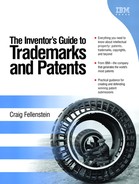Chapter 9. Property Protection: Copyrights, Trademarks, Trade Secrets, Patents, and Publishing Intellectual Property
Intellectual property is protected through copyrights, trademarks, trade secrets, and patents, which you learned about throughout this book. In this chapter, you'll learn how to initiate this protection for your own ideas.
Remember that for a patent, your idea must provide a novel solution to a problem, and the solution must be non-obvious based on common legal practices. If your idea doesn't pass this test, then intellectual property patent laws will not protect your idea.
A trade secret is a unique kind of intellectual property that isn't granted official status because, by its nature, a trade secret is out of public view. Your trade secret is protected by secrecy until the secret is revealed or someone discovers it.
What are the differences between trademarks, copyrights, patents, and trade secrets? They are all generally described as intellectual property. These are forms of intangible property because they maintain property rights that cannot be touched (literally speaking) or physically felt like personal property (e.g., a car, a desk) or real property (e.g., land) (see Figure 9-1). However, the actual terms have distinct meanings and define different attributes of property:
Trademark (®, ™, SM) protects a word, phrase, symbol, and/or design that are utilized with a product or service in the open market. A trademark is often referred to as a brand. Trademark rights may continue indefinitely, as long as the mark is neither abandoned by the trademark owner nor loses its significance in the marketplace as a trademark by becoming a generic term.
Copyright (©) protects the original way an idea is expressed, not the idea itself. It includes artistic, literary, dramatic, or musical works presented in a tangible medium such as a book, photograph, or movie. This protection is given to works to prevent unauthorized copying. The general rule for a work created on or after January 1, 1978, is that the copyright lasts for the author's lifetime plus 70 years after the author's death or 95 years after publication for a work made for hire.
Patent protects a new and useful idea, which includes an article of manufacture and composition of matter. It is granted by the government, providing an inventor with exclusive rights to make, use, and sell a patented invention. Patents have a fixed term, 20 years starting from when the patent application is filed. This goes into effect when the patent is issued.
Trade Secret is held as a secret (e.g., Campbell's Soup recipes, the mud at the core of a baseball, etc.) and is only valid until it is divulged or discovered, and at this stage of public discovery, it is no longer a secret.
Figure 9-1. Variety of common intellectual property classifications.

In this chapter, we will explore all of these concepts and explain in a step-wise fashion exactly how to initiate and complete each one of the protection means in a simple yet legal fashion. Likewise, we will explore the differences in these various types of innovations and how both global societies and businesses typically tend to deal with managing and submitting these types innovations.
